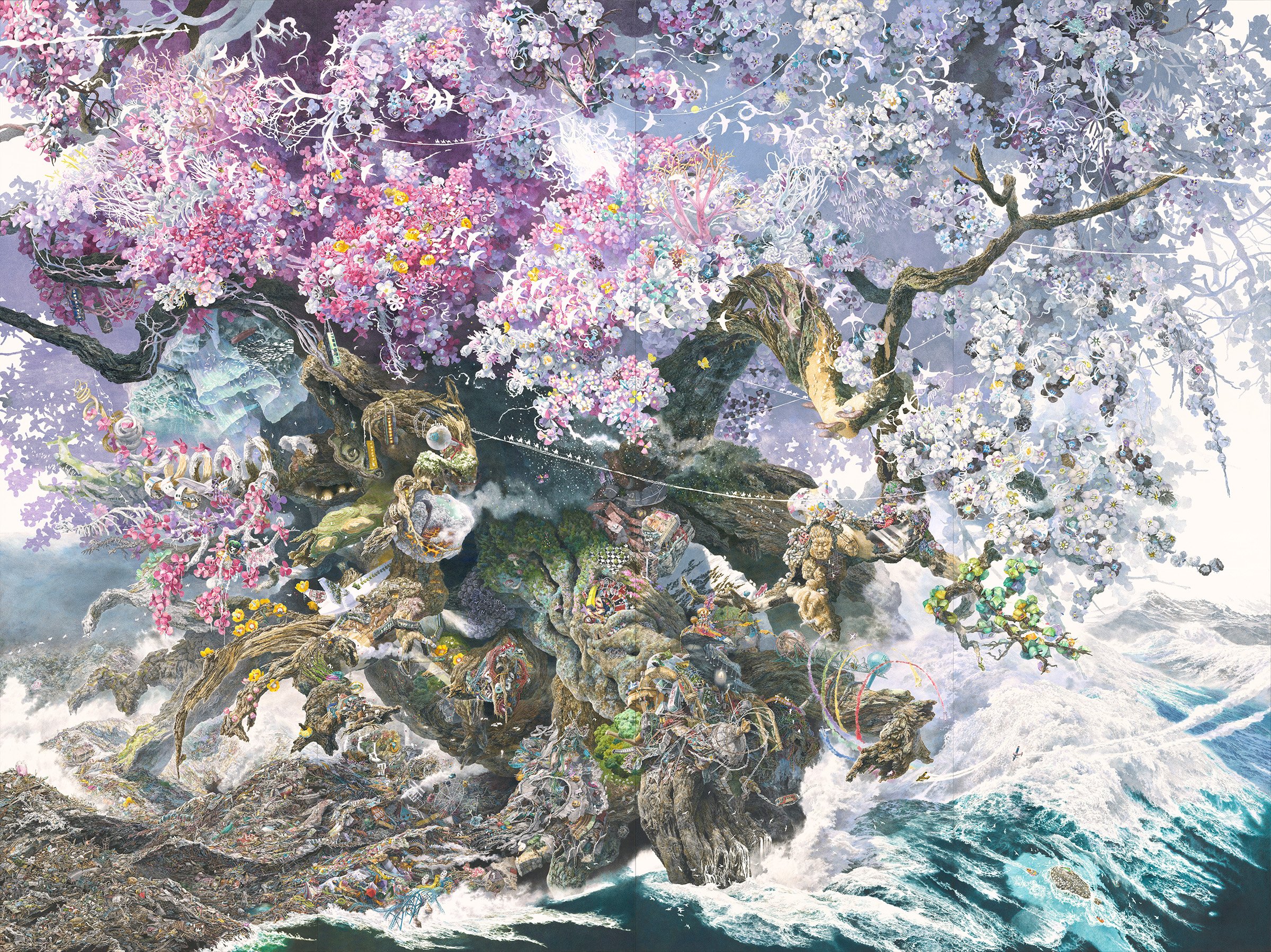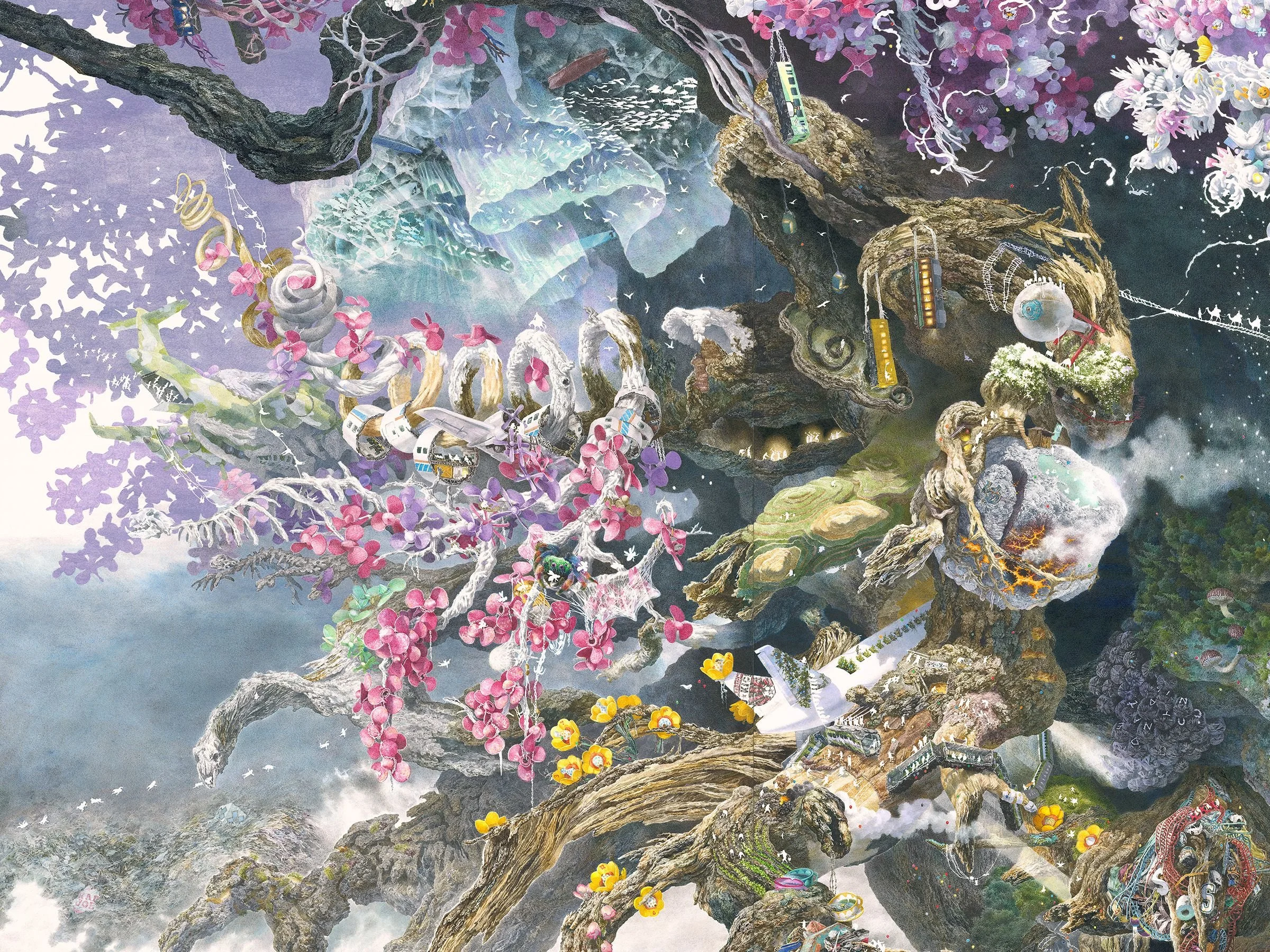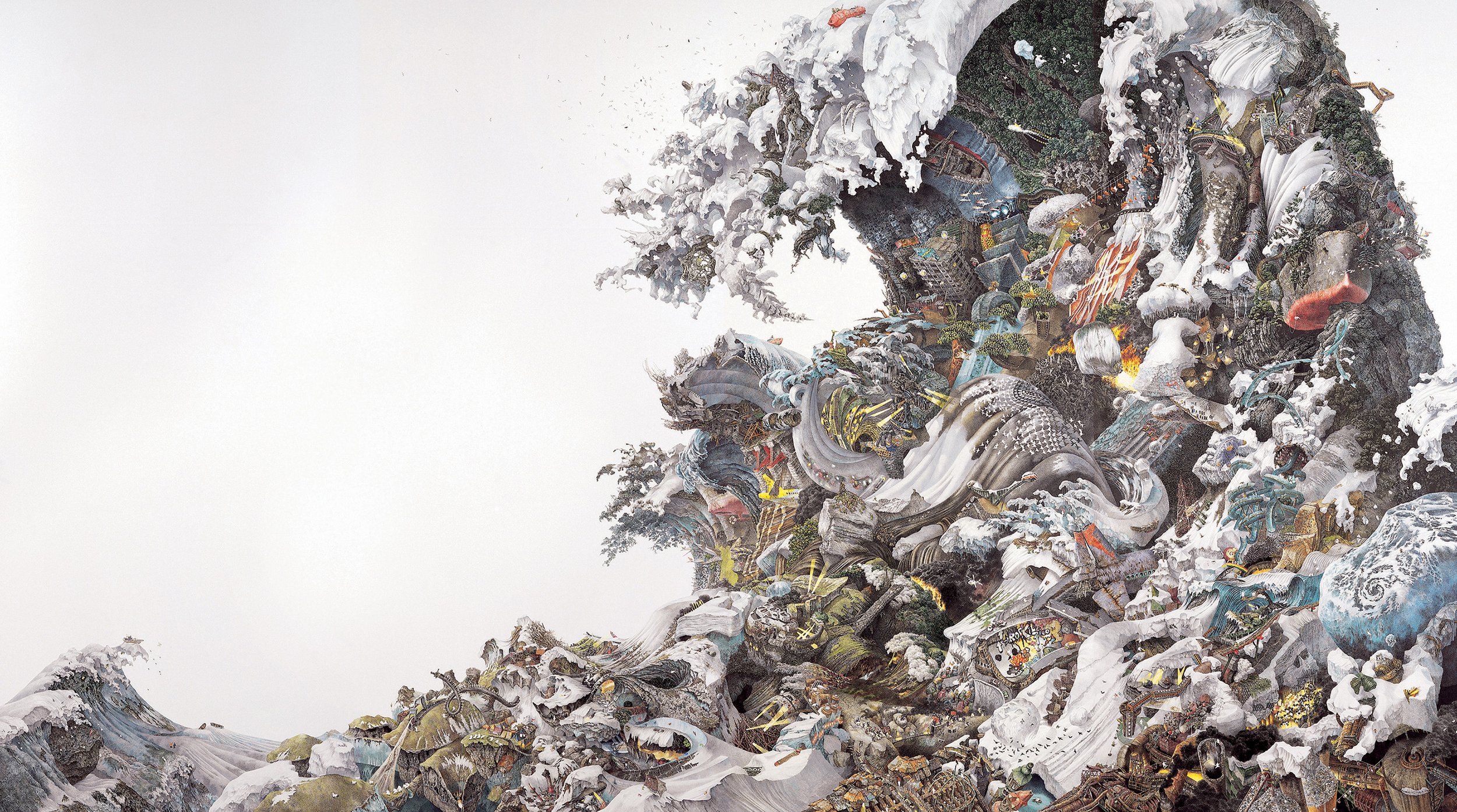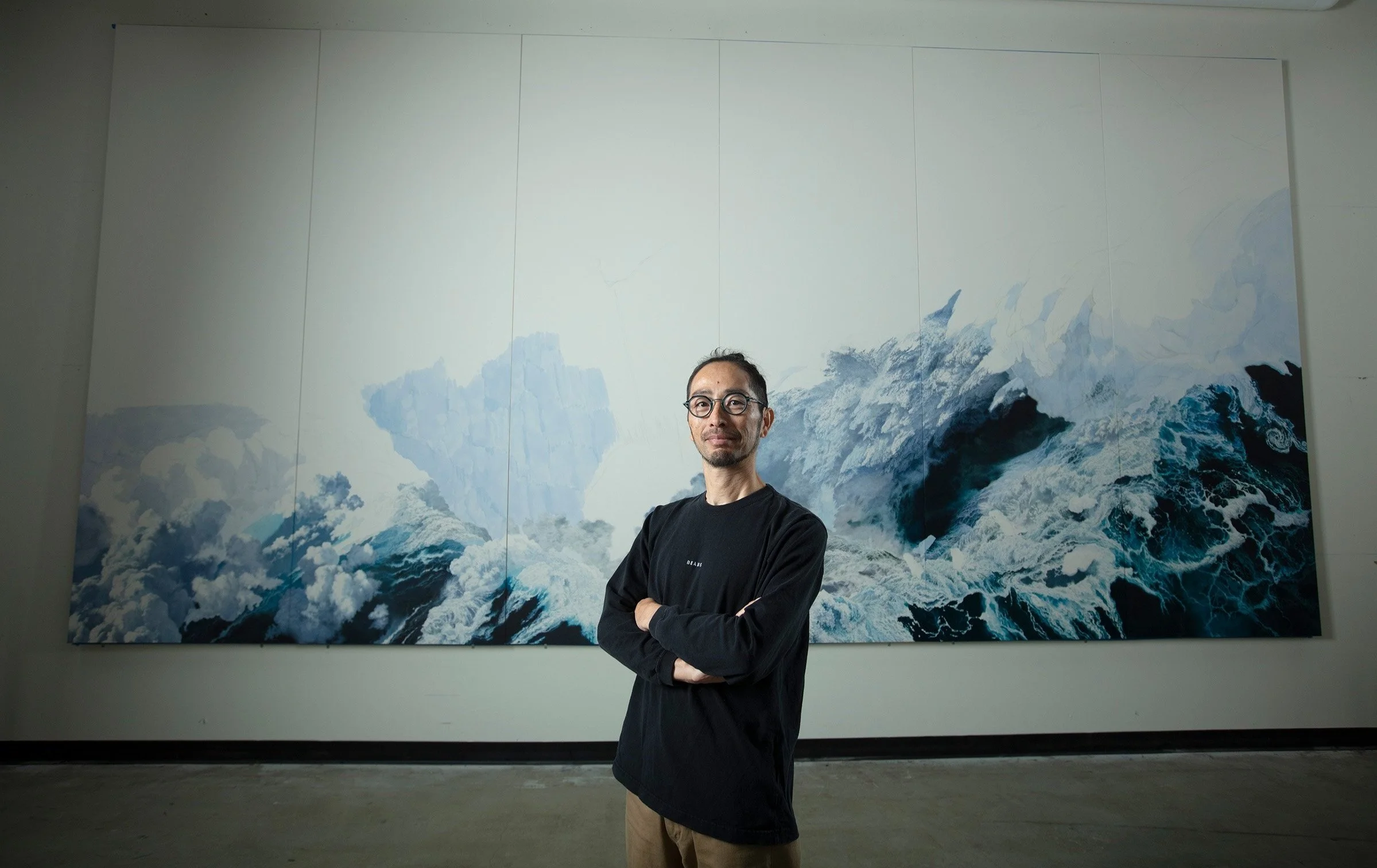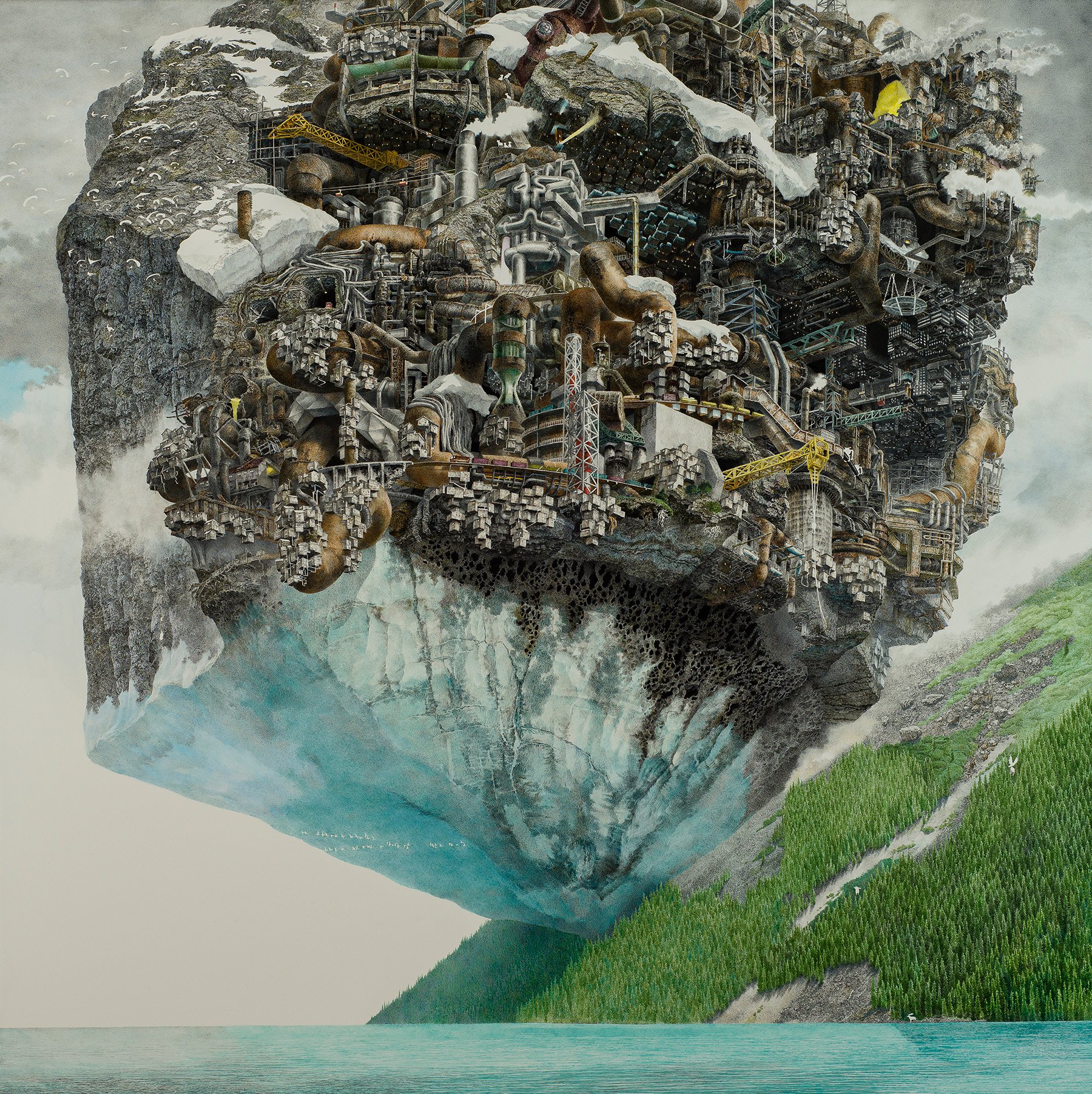Whistler's Audain Art Museum hosts epic exhibition by Japanese visual artist Manabu Ikeda
Flowers from the Wreckage is the first solo exhibition in North America by the artist who draws meticulously detailed large-scale works in pen and paper
Manabu Ikeda, 誕生 Rebirth, 2013–2016—pen, acrylic ink, and transparent watercolour on paper, mounted on board, 300 × 400 cm. Collection of Saga Prefectural Art Museum, Saga, Japan. Digital Archive by Toppan Printing Co., Ltd
Audain Art Museum presents Manabu Ikeda: Flowers from the Wreckage in the Tom and Teresa Gautreau Galleries from June 24 to October 9. The artist is in attendance on Thursdays, Fridays, and Saturdays in studio in AAM’s Upper Galleries from 3 to 4:30 pm until September 4
MANABU IKEDA IS not one for instant gratification. The globally recognized Japanese visual artist crafts marvellously and meticulously detailed large-scale pen-and-ink drawings that hold much, much more than first meets the eye. Consider that it took him more than three years to create Rebirth, his signature piece to date, which refers to the Great East Japan Earthquake of 2011. His next work will take even longer—and comes with several firsts.
Ikeda will be drawing his largest piece ever in the inaugural role of Audain Art Museum’s artist in residence. With his studio now set up in the AAM’s Upper Galleries, he will be drawing there until September 4, the large windows of the space looking out to an emerald swath of trees. Ikeda’s residency is part of Manabu Ikeda: Flowers from the Wreckage, the esteemed artist’s first major solo exhibition in North America, featuring more than 60 works from national and international public, private, and corporate collections. It is also the museum’s first foray onto the international contemporary-art scene.
Kiriko Watanabe, the museum’s Gail & Stephen A. Jarislowsky curator, selected the artist’s works spanning two decades from public, corporate, and private collections in Japan, the U.S., Canada, and Hong Kong. Even long before Michael Audain and his wife, Yoshiko Karasawa, opened the Audain Art Museum in 2016, they dreamed of one day being able to hold an Ikeda exhibition.
The artist started working on his latest and largest multi-panelled piece in 2019, its turbulent, magnificent waves crashing and heaving. Ikeda expects it will take him another two years to complete. Visitors to the museum are able to visit him in studio and observe him while he draws, the space open to the public on Thursday, Friday, and Saturday afternoons from 3 to 4:30 pm throughout the summer.
“This is the largest work I have ever made,” Ikeda says in an interview with Stir, with Watanabe translating. “I want to draw an ocean on the entire surface.”
Ikeda grew up in Saga Prefecture in the 1970s and ’80s, when Japanese anime was becoming more and more popular. Using a nib pen—the same type often used for anime, less than one millimetre thick—he creates worlds upon and within worlds in acrylic ink on paper reflecting everyday objects, nature, pop culture, and more. While it depends on the size of his paper, many of his large-scale works take more than a year to complete. Ikeda has exhibited in Australia, France, Germany, Italy, Korea, Russia, the United States, and beyond.
Manabu Ikeda, 誕生Rebirth (detail), 2013–2016, pen, acrylic ink, and transparent watercolour on paper, mounted on board, 300 × 400 cm. Collection of Saga Prefectural Art Museum, Saga, Japan. Digital Archive by ToppanPrinting Co., Ltd
Ikeda’s imagery gives nods to Japanese art and symbolism while folding in universal themes of suffering and hope in the face of natural and human-made disasters. Then there are references to everything from samurai warriors to North American big-box stores. His work is extraordinarily complex.
Ikeda studied in the department of design at Tokyo University of the Arts, earning his master’s degree in 2000. In 2011, he moved to Vancouver for a year as a research artist on behalf of the Japanese Agency for Cultural Affairs. Two months later, he watched the unfolding of the Great East Japan Earthquake in Tohoku on the Internet. The tsunami unleashed waves as tall as 40 metres that swept entire towns away, and the aftermath also included the Fukushima Daiichi nuclear power disaster.
In 2014 he won a Takashimaya Art Award, given to an artist who represents the highest level of Japanese art and design, a year after moving to his current home base in Madison, Wisconsin.
That’s where he created Rebirth, which is part of Flowers from the Wreckage. He worked on the three-by-four metre piece for eight hours a day on average in the basement studio of the Chazen Museum of Art. If you were to breezily walk by without pausing, you’d see an flowering cherry tree rising out of a menacing wave, but you'd miss out on all sorts of teeny wonders in staggeringly beautiful chaos: A small airplane unfurling (inspired by calamari rings, Watanabe explains), a Home Depot, tents, street signs, white-winged birds, pink canoes disguised in blossoms, fishing nets, jumbles of marine debris, heaps of vehicles, gnarled train tracks, umbrellas, people on camels crossing a bridge, yellow flowers, an amusement park, street signs… Humanity, nature, and disaster meet, but there are so many signs of regrowth and renewal—the birth of Venus, flowers of life, butterflies—just as the people of Japan rebuilt after the terrible events of 2011.
“People and places were washed away by nature’s power,” Watanabe says. “While he was making it [Rebirth], two of his daughters were born and he lost friends. New life springs forth amid destruction.
“During the course of Rebirth, he met a number of people in Madison who had shared their stories and their experiences of disasters—hurricanes, flooding, forest fires—and their stories inspired him to come up with imagery that he also included,” she adds.
The exquisite detail in Rebirth is so intricate that Ikeda wrote a book about it, The Birth of Rebirth, guiding people through 52 exhaustive, numbered sections. He explains that he started out on the epic work without any clear idea of what would emerge, beginning in the far left corner with a pile of twisted scrap metal. He drew one section with his left hand.
Manabu Ikeda,予兆Foretoken, 2008, pen and acrylic ink on paper, mounted on board1, 90 × 340 cm. Collection of Sustainable Investor Co., Ltd. (Kagura Salon) Photo by Yasuhide Kuge
Ikeda’s process differs from that of many visual artists: rather than start with broad strokes and spaces then focusing on finer sections afterward, he starts out one tiny line at a time, not knowing where his pen will end up next or what it will lead to.
“I like drawing with pen and ink and starting with a small section and drawing in details and how the accumulation of the practice of continuous drawing creates a larger imagery,” Ikeda says. Adds Watanabe: “It makes him excited to see what the small parts will eventually become.”
The new drawing that Ikeda is working on in Whistler will be two metres wider than Rebirth and, like the former, will incorporate watercolour. It’s a departure for the married father of four young kids: the elements that previously characterized his work—plants, trees, animals, humans, creatures, vehicles, buildings, and mountains—are absent. He’s focusing on a huge body of water unto itself, ever in awe of Mother Nature.
“Up until this work, his works included so many different things: ships, cars, people, trains: you name it, it’s all in there, but in this large work, he’s only drawing waves and the clouds,” Watanabe says. “For those who truly enjoy his work for all different things that are being depicted, this new work may not appeal to them. But he says ‘For me, I feel that in order for me to hone my skills as an artist and reach a higher level, this is something I shouldn't avoid.’ He needs to endeavour to do this. It’s the most difficult ever of all the drawings he’s done. There’s a shift in his expression.”
Ikeda says: “It’s very risky. Up until now my works have included a number of little stories and I’ve drawn many different things in detail, however in this new work I want to express a feeling of being in a large space, an open space, and express that scale. It’s not difficult for me to draw things in detail using the pen and paper but to draw something so large, something that open and that allows the viewer to feel the space, the grand space, is a challenge. It’s not just the size of the work being larger and greater but also the style of drawing and what I express.”
Manabu Ikeda in front of a new work in progress, 2019—pen, acrylic ink, and transparent watercolour on paper, mounted on board, 300 × 600 cm. Courtesy of the artist and Mizuma Art Gallery. Photo by Eric Baillies
Watanabe first saw Ikeda’s work over 10 years ago, when she was working at the West Vancouver Art Museum. It exhibited the artist’s monumental Meltdown from 2013, which is also in the Audain show and depicts an enormous industrial complex set into a block of ice and rock. It speaks to the dangers of atomic energy but also is loaded with small elements, like people dangling from parachutes and hang gliders and white silhouettes of various creatures. She remembers being in awe—and not being the only one.
“It was really my first time to see people stand in front of an artwork for easily five to 10 minutes,” Watanabe says. “That’s a really long time as the average time each person spends when they go to see an art exhibition is something like 40 seconds. The level of engagement the viewer will have with Manabu’s exhibition is incredible.”
“Many of his works have major themes of civilization versus nature, their coexistence and friction between them,” she adds. “And he likes to also create his own stories taking in real things that have a twist in his head; when it comes out on paper it has an element of something that is familiar, but it’s not exactly what you think it is. Another appeal of his drawing is that it triggers your own understanding of the world. However it’s his, and it comes out with a twist, from his imaginary world. I think that makes the experience of viewing more fascinating and mesmerizing.”
There’s humour in his work, too. Watanabe points to one section that at first glance looks like a menacing tsunami swiping away everything in its path, which is in fact an ice formation. “It’s a playground for skiers,” she says. “He likes mountain climbing, skiing, and fishing, so his ideas of humour that are expressed in his drawings often come from his own interests.”
Manabu Ikeda, Meltdown, 2013, pen and acrylic ink on paper, mounted on board, 122 × 122 cm. Chazen Museum of Art, University of Wisconsin–Madison Colonel Rex W. and Maxine Schuster Radsch Endowment Fund purchase, 2013.24
Watanabe has divided the exhibition into several themes, including artistic response to catastrophe as well as prophetic vision. It seems that Ikeda has a certain sense for the future.
Consider Foretoken (2008) and what at first glance looks like a violent wave. “This drawing was made prior to the 2011 March 11 earthquake,” Watanabe says. “After the earthquake and tsunami, viewers started to perceive it as if he has predicted it.” The imagery in the painting was deemed so triggering to survivors that it was temporarily removed from public view.
Then there’s Gate from 2010. “The work itself resembles the architecture design of the September 11 memorials museum in New York,” Watanabe says. With Ikeda’s composition and planes, the resemblance to Ground Zero, built four years later, is eerie.
The exhibition also features some animal and pencil drawings that will appeal in particular to young viewers and those who love nature.
There’s something ever so simple that strikes Watanabe about Ikeda’s work: “All he uses is pen and paper,” she says. “These are art supplies that just about any of us has. It could encourage anyone to draw. It’s inspiring to see how an artist like him could create serious artwork that would really bring us awe, that is visually shocking. You spend more and more time and realize what you are seeing has more information than you can visually process at first. It’s a very interesting experience in itself.”


